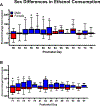Adolescent intermittent ethanol exposure induces sex-dependent divergent changes in ethanol drinking and motor activity in adulthood in C57BL/6J mice
- PMID: 33725399
- PMCID: PMC8957701
- DOI: 10.1002/jnr.24814
Adolescent intermittent ethanol exposure induces sex-dependent divergent changes in ethanol drinking and motor activity in adulthood in C57BL/6J mice
Abstract
With alcohol readily accessible to adolescents, its consumption leads to many adverse effects, including impaired learning, attention, and behavior. Adolescents report higher rates of binge drinking compared to adults. They are also more prone to substance use disorder in adulthood due to physiological changes during the adolescent developmental period. We used C57BL/6J male and female mice to investigate the long-lasting impact of binge ethanol exposure during adolescence on voluntary ethanol intake and open field behavior during later adolescence (Experiment 1) and during emerging adulthood (Experiment 2). The present set of experiments were divided into four stages: (1) adolescent intermittent vapor inhalation exposure, (2) abstinence, (3) voluntary ethanol intake, and (4) open field behavioral testing. During adolescence, male and female mice were exposed to air or ethanol using intermittent vapor inhalation from postnatal day (PND) 28-42. Following this, mice underwent short-term abstinence from PND 43-49 (Experiment 1) or protracted abstinence from PND 43-69 (Experiment 2). Beginning on PND 50-76 or PND 70-97, mice were assessed for intermittent voluntary ethanol consumption using a two-bottle choice drinking procedure over 28 days. Male adolescent ethanol-exposed mice showed increased ethanol consumption following short-term abstinence and following protracted abstinence. In contrast, female mice showed no changes in ethanol consumption following short-term abstinence and decreased ethanol consumption following protracted abstinence. There were modest changes in open field behavior following voluntary ethanol consumption in both experiments. These data demonstrate a sexually divergent shift in ethanol consumption following binge ethanol exposure during adolescence and differences in open field behavior. These results highlight sex-dependent vulnerability to developing substance use disorders in adulthood.
Keywords: AIE; adolescence; alcohol; dependence; development; mouse; sex differences.
© 2021 Wiley Periodicals LLC.
Conflict of interest statement
Conflict of Interest Statement: The authors declare no conflict of interest.
Figures





Similar articles
-
Adolescent intermittent ethanol exposure alters adult exploratory and affective behaviors, and cerebellar Grin2b expression in C57BL/6J mice.Drug Alcohol Depend. 2023 Dec 1;253:111026. doi: 10.1016/j.drugalcdep.2023.111026. Epub 2023 Nov 10. Drug Alcohol Depend. 2023. PMID: 38006668 Free PMC article.
-
Adolescent Intermittent Ethanol Exposure Alters Adult Exploratory and Affective Behaviors, and Cerebellar Grin2B Expression in C57BL/6J Mice.bioRxiv [Preprint]. 2023 Sep 17:2023.02.13.528396. doi: 10.1101/2023.02.13.528396. bioRxiv. 2023. Update in: Drug Alcohol Depend. 2023 Dec 1;253:111026. doi: 10.1016/j.drugalcdep.2023.111026. PMID: 36824954 Free PMC article. Updated. Preprint.
-
Repeated binge ethanol administration during adolescence enhances voluntary sweetened ethanol intake in young adulthood in male and female rats.Pharmacol Biochem Behav. 2010 Oct;96(4):476-87. doi: 10.1016/j.pbb.2010.07.008. Epub 2010 Jul 15. Pharmacol Biochem Behav. 2010. PMID: 20637794 Free PMC article.
-
Mechanisms of Persistent Neurobiological Changes Following Adolescent Alcohol Exposure: NADIA Consortium Findings.Alcohol Clin Exp Res. 2019 Sep;43(9):1806-1822. doi: 10.1111/acer.14154. Epub 2019 Aug 14. Alcohol Clin Exp Res. 2019. PMID: 31335972 Free PMC article. Review.
-
Adolescent alcohol exposure: Are there separable vulnerable periods within adolescence?Physiol Behav. 2015 Sep 1;148:122-30. doi: 10.1016/j.physbeh.2015.01.027. Epub 2015 Jan 23. Physiol Behav. 2015. PMID: 25624108 Free PMC article. Review.
Cited by
-
Adolescent Intermittent Ethanol Drives Modest Neuroinflammation but Does Not Escalate Drinking in Male Rats.Cells. 2023 Nov 4;12(21):2572. doi: 10.3390/cells12212572. Cells. 2023. PMID: 37947650 Free PMC article.
-
Sex differences in the effects of adolescent intermittent ethanol exposure on exploratory and anxiety-like behavior in adult rats.Alcohol. 2022 Feb;98:43-50. doi: 10.1016/j.alcohol.2021.11.002. Epub 2021 Nov 19. Alcohol. 2022. PMID: 34808302 Free PMC article.
-
The role of sex in the persistent effects of adolescent alcohol exposure on behavior and neurobiology in rodents.Int Rev Neurobiol. 2021;160:305-340. doi: 10.1016/bs.irn.2021.07.007. Epub 2021 Aug 11. Int Rev Neurobiol. 2021. PMID: 34696877 Free PMC article. Review.
-
The impact of adolescent drinking on traumatic brain injury-induced cognitive deficits and alcohol preference in adult C57BL/6J mice.Alcohol Clin Exp Res (Hoboken). 2025 May;49(5):1013-1027. doi: 10.1111/acer.70027. Epub 2025 Mar 23. Alcohol Clin Exp Res (Hoboken). 2025. PMID: 40123100
-
Adolescent Intermittent Ethanol (AIE) Enhances the Dopaminergic Response to Ethanol within the Mesolimbic Pathway during Adulthood: Alterations in Cholinergic/Dopaminergic Genes Expression in the Nucleus Accumbens Shell.Int J Mol Sci. 2021 Oct 29;22(21):11733. doi: 10.3390/ijms222111733. Int J Mol Sci. 2021. PMID: 34769161 Free PMC article.
References
-
- Alaux-Cantin S, Warnault V, Legastelois R, Botia B, Pierrefiche O, Vilpoux C, Naassila M, 2013. Alcohol intoxications during adolescence increase motivation for alcohol in adult rats and induce neuroadaptations in the nucleus accumbens. Neuropharmacology 67, 521–531. 10.1016/j.neuropharm.2012.12.007 - DOI - PubMed
-
- Amodeo LR, Wills DN, Sanchez-Alavez M, Nguyen W, Conti B, Ehlers CL, 2018. Intermittent voluntary ethanol consumption combined with ethanol vapor exposure during adolescence increases drinking and alters other behaviors in adulthood in female and male rats. Alcohol 73, 57–66. 10.1016/j.alcohol.2018.04.003 - DOI - PMC - PubMed
Publication types
MeSH terms
Substances
Grants and funding
LinkOut - more resources
Full Text Sources
Other Literature Sources
Medical

